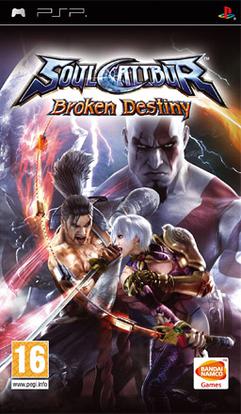Gameplay
The ability to change physical attributes and muscularity, which was present in Soulcalibur IV, has been removed. In this game, however, it has been replaced by the ability to adjust the rotation, position and size of some equipped items, such as certain headwear which might not fit exactly right, depending on what hairstyle is selected. Original characters can not be re-dressed with custom character items like in Soulcalibur IV, although their colors may be edited. In addition to editing the characters' appearance, the player may create a custom vs. screen photo for each custom character. The player has some control over the character's pose in the photo, as well as the camera position and the photo's frame and background. The number of custom character slots has been reduced from 50 in Soulcalibur IV to 16 in Broken Destiny.
Soulcalibur: Broken Destiny features an English language and Japanese language mode for both text and speech. Custom characters, however, can only be named using the ASCII naming interface, regardless of the language setting.
- Quick Match is a mode where players are given a list of A.I. players with their titles and stats and choose which opponent to fight. Players who have won against the A.I will receive "unique titles" that you can wear, the "title" is under their name during Versus Mode.
- The Gauntlet is the tutorial and story mode for Soulcalibur: Broken Destiny, which has similar story telling features like Soulcalibur II's Weapon Master mode, although the player is informed at the start that this story is non-canonical. Players are often given low health and required to guard or perform attacks within a short window of opening of the A.I. controlled tutor. There are altogether 34 chapters of tutorial in The Gauntlet, with two to four sub-missions in each of the stages. Players will need to clear all sub-missions with Rank A in order to unlock the next chapter. As a reward for completing The Gauntlet, players are given a new 'Broken Destiny' weapon for the character Siegfried.
- Trials consists of three portions — Trial of Attack, Trial of Defense, and Endless Trials. All of the portions are round-based battles. Trial of Attack rewards score according to how well a player can chain the attacks. Trial of Defense rewards score according to how well a player guard attacks and counterattacks. Endless Trials essentially combine both of the above trials and endless stages much like survival mode.
- Versus Mode is similar in features to Quick Match, except that the players are nearby PSP players who connect wirelessly through an ad hoc network.
- Training Mode which allows player to test out moves and practice in controlled condition, much the same as Practice Mode/Training in other previous Soulcalibur games.
This page is based on this
Wikipedia article Text is available under the
CC BY-SA 4.0 license; additional terms may apply.
Images, videos and audio are available under their respective licenses.
